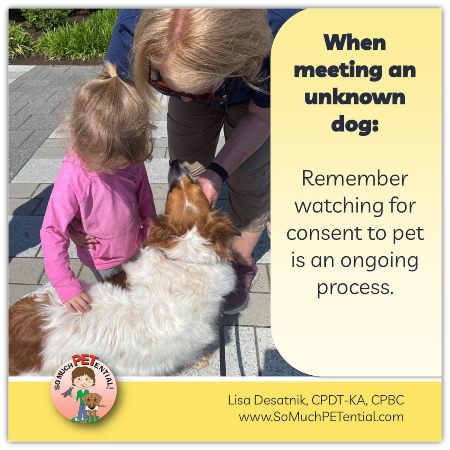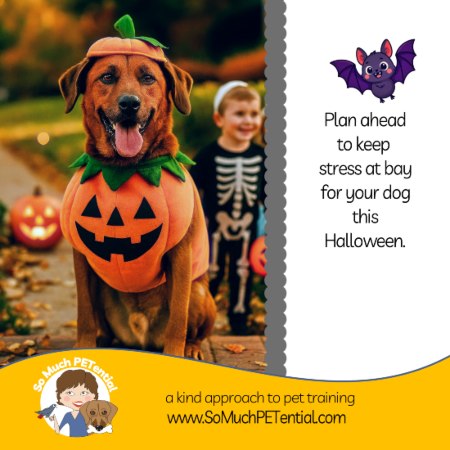There has been a lot published about the subject of how to greet an unknown dog. Many written with kids and dogs in mind, and dog bite prevention. Ask permission from the handler. Ask permission from the dog. Allow the dog to approach you. Stand sideways, present your fist or palm, and let the dog sniff you first. These are all generally good tips. I wanted to delve into this further to share more information.
 CONSIDERATIONS BEFORE INTERACTING
CONSIDERATIONS BEFORE INTERACTING
Be aware of the situation.
Take a look around. Are you in a home or a park with lots of distractions? Is the dog’s ability to move being restricted by a crate, a tight chain or leash? What equipment is the dog wearing? If the dog is wearing a prong collar or an e-collar, straining or doing behaviors the handler does not want could result in the dog having something aversive happen that could become associated with you or your child. Is the dog person holding the leash an adult or a child? A child may not be able to control the leash if the dog lurches forward. Is the dog being physically or verbally corrected? Is the dog tethered to a post outside a shop unattended?
Answers to these questions can impact the dog’s behavior in that situation. A dog may play with or solicit pets from kids when off leash or in a comfortable environment but if that same dog is overstimulated or stressed by the busy environment or way in which it is being restrained, it may be more likely to react in barking/lunging/growling or other responses.
Ask for consent.
Yes, it is important to ask both the handler AND the dog. Keep in mind that not all handlers are aware of dog body language so even if the handler says it is ok to greet his/her dog, it may not be and it also does not mean the dog will appreciate all kinds of interaction. I’ll expand more on this below.
Don’t be offended if the dog handler says no. There could be so many reasons. Maybe, although their dog seems relaxed, if approached, it could react in barking or lunging or growling. Maybe the dog is in training. Maybe the dog is not feeling well.
Asking the dog involves observing the dog. Is the dog showing body language that is asking for distance or for more interaction? At the bottom of this post are signs to watch for.
Consent is an ongoing process.
During the interaction, it is important to continue paying attention to the dog’s body language as permission to pet may change depending on many things like the environment or the way in which the person is interacting with the dog. A good rule of them is to continually watch the dog and also pause from your interaction after a minute. Is the dog wanting more or is the dog wanting distance? Pay attention to what the dog likes about the interaction – you will know by whether the dog wants more or less. If the dog wants distance, stop your interaction and allow the dog to move away (or you move away).
HOW TO INTERACT
Respect personal space.
Think about this in terms of how YOU would feel. You or your child may likely feel threatened or violated if a stranger were to stand close to you and face you directly. You also probably would not appreciate someone randomly sticking their hand or face in your face or rubbing your head.
Many dogs also feel uncomfortable with this kind of interaction. I have seen many instances where kids move quickly into a dog’s space and then reach their hand out in a fist for the dog to smell – with the unknown dog backing up, barking or growling at them. I have also heard about many dog bites that have occurred after someone has put his/her face right up to a dog’s face. (When there is more going on in the environment to cause stress in the dog, that reaction can be even more likely.)
Teach kids – and practice yourself – staying at a distance where the dog can continue to be comfortable (see the list of body language below) and allow the dog to approach you. When the dog is close enough, rather than pushing a fist into the dog’s face, still allow the dog to approach your fist.
Note that even when a dog looks eager to approach (see the signs below) from a distance, that same dog can suddenly feel unsafe when too close, especially if the person or dog does something that scares it.
What you communicate matters
Just as dogs use their bodies to indicate whether they want more or less space, are happy, stressed or angry, they also pay attention to how people use their bodies. Kids who run around, flailing arms and yelling can cause dogs to be stressed or overstimulated. That could lead to the dog wanting to chase, lurch on his/her leash, bark, jump, or become bitey. For that matter, sudden movements can cause some dogs to at minimum startle. Deep or high-pitched voices can also cause these reactions. Additionally, looming over a dog can also cause a dog to show distance increasing behaviors. (see below)
Keep your body relaxed and avoid leaning over the dog. For small dogs, squatting down to their level while staying to the side or front of the dog will help them to feel more comfortable and increase the likelihood of your seeing distance decreasing behaviors.
Avoid staring.
I have many friends who have disabilities or other differences and I have heard how uncomfortable it makes them when someone stares at them. Children especially seem prone to do this. Dogs also see that as threatening. This is why is can also be helpful to turn slightly sideways instead of facing directly toward the dog, and avert direct eye contact as dogs may see that as threatening.
How and where you touch matters.
If a stranger (or even someone in your inner circle) comes up to you or your child and touches you in ‘inappropriate’ places, that could be considered sexual assault.
Even from their beloved family members, many dogs show avoidance behaviors when they are rubbed on top of their head, grabbed or pulled at, hugged, or laid on.
Teach kids – and practice yourself – to avoid pulling on dog body parts, hugging, leaning over dogs and puppies. Instead, longer strokes on the side or underneath the dog’s muzzle, or side or back of the dog are often better.
With all of these tips…please ALWAYS keep in mind that these are generalities.
EVERY dog and EVERY puppy is an individual with his/her own preferences and
comfort levels. This is why it is ALWAYS good to be watching for the dog or
puppy’s consent throughout the interaction.
Some signs that a dog wants distance
tongue flicks (quick flicks or licking of the tongue)
blinking
open eyes and maybe showing the whites around the perimeter
furrowed eye brow area
heaving breathing
tight closed mouth
averting eye contact and turning its head away or leaning away
ears pinned back or stiffened depending on the dog
movement away
tense body muscles
body shake off
lowering of body (to make him/herself look smaller)
tail lowered or between his/her legs (a tense straight up tail with a tight body can also be a caution)
yawning
excessive sniffing of the ground
rolling over onto his/her back with stiff muscles, either avoiding eye contact or staring right at you
NOTE: If the dog is stiffened and hard staring directly at you, growling, deep barking, that is a very unsafe dog.
Some signs that a dog wants less distance
soft, open mouth
ears at regular posture
soft eyes and body (no tension)
balanced weight on all four legs
loose wagging tail
may pant gently
pushing his/her face or body into you
play bow or greeting stretch (in the presence of a loose body)
An excellent book with illustrations, written for easy understanding for kids is Doggie Language by Lili Chin.







